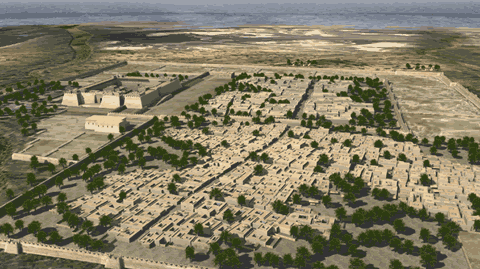At its time the Indus Valley Civilization city of Dholavira, founded in 3000 B.C. might have been the most technically advanced city in the entire world. Here as it might have looked around 2100 B.C. With a population of 15,000-20,000 at 0.6km² a density similar to Manhattan. 







Located on the island of Khadir in the great salt desert of the Kutch, just on the edge of the monsoon region, meaning that its ground water was salty or brackish, and the monsoon rains often failed: it could go several years without a drop of rain. But the city had ample water!
One third of the city was devoted to water management: huge reservoirs cut deep into the rock was used to store fresh water from two rivers that only came to life during monsoons. These reservoirs linked to wells, silting tanks, etc. offering better water than many modern cities. 



In addition to the monsoon river fed reservoirs it had a storm water system that prevented flooding and stored rain water for public use as well as a sewage system for grey water that took household waste water to be used in gardening and agriculture outside the stone city walls. 

Dholavira was a trading city connected by a fleet of sailing ships and caravans as far as Egypt, Persia, Mesopotamia, the Black Sea, Oman, Kuwait, India, and so on. It was built purposefully placed right on the tropic of cancer and its citizens knew mathematics and astronomy. 



Dholavira's city walls were also some of the largest ever built, between 14-18m thick and at least 9m tall. This was at a time when the strongest weapons were bows and slings, the walls were not for war: they were most likely to protect the city against destructive tsunami. 

The thickest walls faced south, towards the ocean, which at this time was about 3m higher than now, when the ruins are 160km from the coast. 

• • •
Missing some Tweet in this thread? You can try to
force a refresh




































